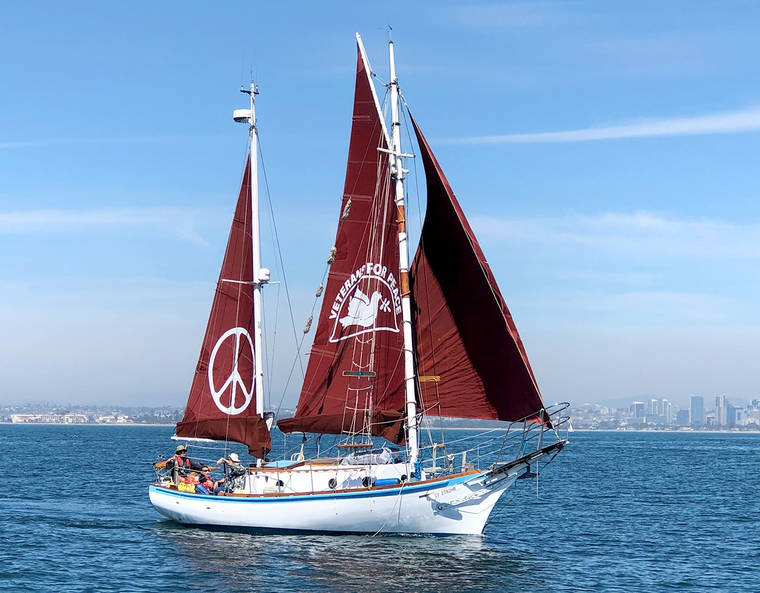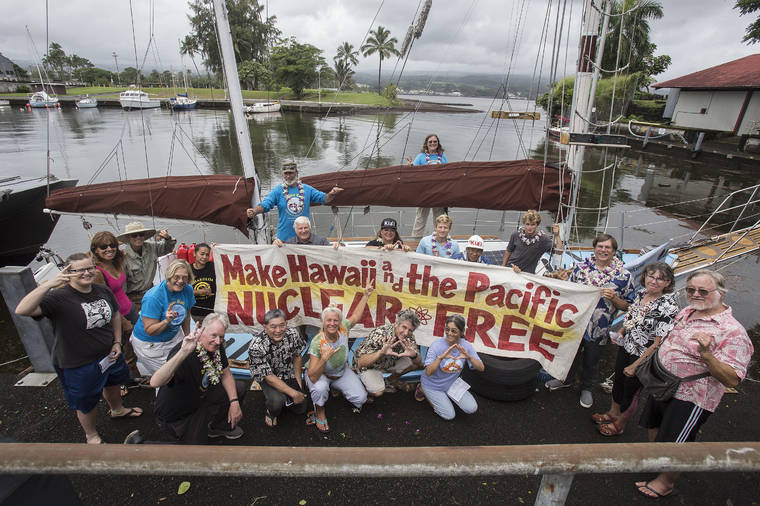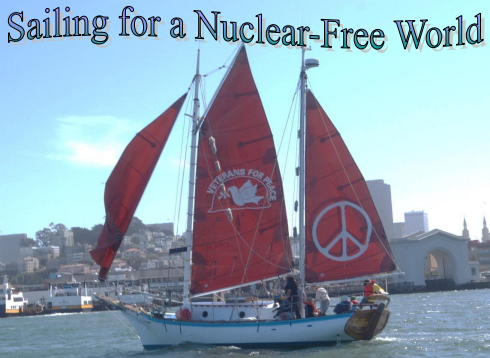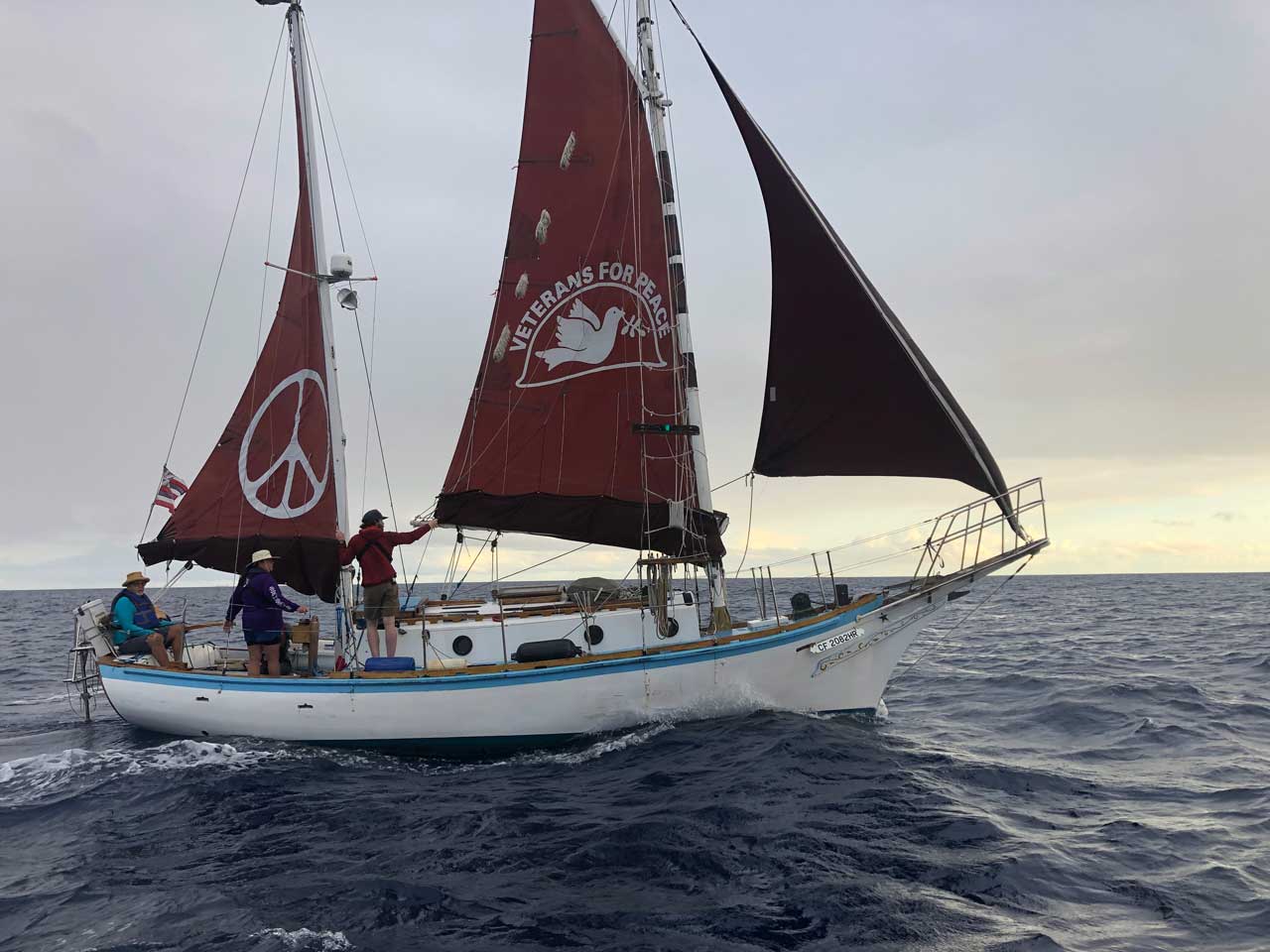
65 years ago, the Golden Rule ignited protests that led to a partial ban
on nuclear weapons testing. Now it’s back to fight for nothing short of abolition
The Golden Rule Is Back to
Inspire a Whole New Generation
Arnie Alpert / Waging Nonviolence
(May 1, 2023) — Fredy Champagne has been a peace activist ever since he returned from combat in Vietnam. He’s been kicked out of college, where he was accused of starting a riot. He’s opened health clinics in Vietnam. He’s delivered school buses to Cuba. But in 2010, he received a call that opened his eyes to a story of resistance he had never heard before.
The call was from one of Champagne’s fellow members of Veterans for Peace, or VFP, asking him to go check out a boat that had been hauled out of the water in Humboldt Bay, California — only an hour’s drive north from his home in Garberville, where he was serving as the president of the local VFP chapter.
The boat — named the Golden Rule — wasn’t much to look at. It was far from seaworthy, and those who had already looked it over thought it was better suited for firewood than seafaring. “A lot of the side planking was gone,” Champagne said. “There was absolutely no interior. It was all rotten. And there was no steering mechanism, no mast, no motor, no nothing.”
But there was more to this broken-down old ship than what the eye could see. This vessel was a piece of history — having once played a consequential role in making the world safe from above-ground nuclear weapons testing. In 1958, the Golden Rule’s former owners, a group of peace activists, tried to sail it into the American nuclear weapons testing zone in the Pacific as a form of protest. While the authorities cut their voyage short, the Golden Rule still managed to spark an upsurge of opposition to nuclear testing, leading five years later to the adoption of the Partial Test Ban Treaty.
When Champagne learned this history, he was shook. “I was standing there. It was real quiet at the shipyard… And I felt the boat was talking to me. I felt the boat’s spirit. And you know what it said? I sensed that the boat was telling me, ‘Get off your ass and do something.’”
So, do something he did. Champagne set about restoring the boat along with a small team of several other VFP members. Five years later, the Golden Rule was sailing down the West Coast to the 2015 VFP National Convention in San Diego.
Now, in the midst of its Great Loop Tour circling the entirety of the eastern United States, the 21st century Golden Rule aims to be more than a history lesson. Veterans for Peace and the project’s many supporters are working for nothing less than igniting a new movement to abolish nuclear weapons altogether.
Nuclear Dread Inspires Nonviolent Action
The story of the Golden Rule begins, in a sense, with the explosion of the atomic bomb over Hiroshima in 1945.
Writing in the February 1958 issue of the radical pacifist journal Liberation, former US Navy Commander Albert Bigelow recalled that he was “absolutely awestruck,” even though he “had no way of understanding what an atom bomb was.” In that moment, he said he intuitively “realized for the first time that, morally, war is impossible.”
With his wife, Sylvia, he joined the Religious Society of Friends — becoming Quakers and turning toward the kind of activism that would eventually lead him to the Golden Rule. One of his first actions, however, was to host two “Hiroshima Maidens,” young women disfigured by radiation who came to the United States for plastic surgery in the mid-1950s.
Nonviolent direct action against the nuclear threat was only just beginning to take shape. In 1955, activists in New York and other cities began to engage in non-cooperation with civil defense drills. Outcries grew even louder when the Soviet Union and Britain joined the nuclear club — and the introduction of the hydrogen bomb greatly expanded the destructive potential of nuclear weapons. Military leaders such as Gen. Omar Bradley and public intellectual Lewis Mumford were trying to alert the public by November 1957.
The health impact of atmospheric testing had drawn special concern, including that of prominent physicists and public health experts who warned that radioactive fallout would spread cancer far from the testing sites. As Bigelow put it, “The overwhelming weight of scientific opinion said any nuclear explosion was dangerous.” The point was evident from an anti-testing petition circulated by Nobel Prize winner Linus Pauling, which attracted more than 2,000 signatures in just a couple weeks. Even scientists from the US Atomic Energy Commission, or AEC, recognized that fallout would cause hundreds of thousands of deaths worldwide.
Nuclear dread had even made its way into popular culture with, for example, the 1954 release of the Japanese monster film, “Godzilla,” based on the mutating effects of radiation.
While concern spread, it wasn’t until a May 29, 1957 meeting among representatives of the era’s leading pacifist groups that a movement propelling popular action began to form. The War Resisters League, Catholic Worker, Fellowship of Reconciliation, American Friends Service Committee and the Women’s International League for Peace and Freedom all agreed to form the ad hoc committee Non-Violent Action Against Nuclear Weapons, known to its members as NVA. [SANE, the National Committee for a Sane Nuclear Policy, was formed at the same time, with an explicit intention to involve non-pacifists and to leave direct action to others.]
The power of nonviolence was already in the air, following the successful conclusion of the Montgomery Bus Boycott, which made its potential apparent to many people who had not given it serious consideration. Moreover, there were already close connections between the Black freedom movement and pacifist leaders such as Bayard Rustin of WRL and Glenn Smiley of FOR, both of whom advised the Montgomery movement. (Martin Luther King Jr. spoke out publicly in favor of banning the bomb and abolishing war as early as December 1957.)
Jim Peck, who later joined the Golden Rule crew, had organized for desegregation inside the federal prison where he was jailed for draft resistance during World War II. He had also participated with Rustin and others on the 1947 Journey of Reconciliation, the first Freedom Ride.
NVA’s first action was at the site of atomic testing in Nevada on Aug. 6, 1957, the 12th anniversary of the Hiroshima bombing. As Bigelow wrote, about three dozen people began a prayerful vigil in the early morning hours, then, “Eleven of us, in twos and threes, rose from the prayer vigil at intervals, approached the main gate, talked to the 40 or more armed men there, and crossed the line into the project as an act of protest.”
Those who crossed the line, including Bigelow, Peck and Lillian Willoughby, were arrested, tried and given suspended sentences in time to rejoin the vigil the next morning, during an atomic test. “At dawn,” Bigelow said, “we experienced, from a distance of about 25 miles, a nuclear explosion. This was proof that our intuition, our feeling, and our senses were right. We knew that we could never rest while such forces of evil were loose in God’s world.”
The actual inspiration for sailing a ship in the testing zone came from England, where pacifists were talking about forming a “Peace Navy” and sailing into the British test zone at Christmas Island in February 1957. By April, they had formed the Emergency Committee for Direct Action Against Nuclear War. Harold Steele, a member, began making plans to sail into the test zone after trips to India and Japan.
Although Steele’s Pacific trip never took place, the concept crossed the Atlantic. Bigelow and Bill Huntington began shopping for a suitable boat in December 1957, with Huntington eventually finding the ketch that would be named the Golden Rule in Los Angeles. Their sights were set on Eniwetok Atoll in the Marshall Islands, where the United States had been testing nuclear weapons since 1946.

The Voyage of the Golden Rule
Since there were no laws barring a sailboat from the open Pacific, the original voyage had not been envisioned as an act of civil disobedience. In a Jan. 9, 1958 letter to President Eisenhower, Bigelow, Huntington, George Willoughby and NVA Coordinator Lawrence Scott, all Quakers, said in a plain fashion, “We write to tell you of our intended action regarding the announced spring test explosions of American nuclear weapons.”
“Four of us,” the letter continued, “with the support of many others plan to sail a small vessel into the designated area in the Pacific by April 1. We intend, come what may, to remain there during the test period in an effort to halt what we feel is the monstrous delinquency of our government in continuing actions which threaten the well-being of all men.”
On behalf of the American Friends Service Committee, Bigelow had already tried to deliver to the White House a stack of more than 17,000 petitions calling for an end to nuclear testing. Hoping for a meeting with a staff person he knew, Bigelow was told instead to leave them with a police officer at the White House gate. As he wrote in the February 1958 issue of Liberation, “The experience has strengthened my conviction that we must, at whatever cost, find ways to make our witness and protest heard.”
The Golden Rule set off from San Pedro, California that spring, but turned back due to bad weather and to replace a seasick crew member with Orion Sherwood, who had been teaching at a Quaker school in New York. Sherwood, who now lives in Salt Lake City, said when he found out about the need for another crew member, he quickly sent a letter expressing interest.
Sherwood’s brother had been a B-29 pilot in the Pacific, dropping incendiary bombs on Japan and flying over Hiroshima. “One of the crew at least was taking pictures of the results of the atom bomb. And he did the same for the second bombing of Nagasaki,” Sherwood said. “I certainly was hopeful that somehow we would get beyond the testing and have an agreement that we would not continue.” Soon after expressing interest, he was on a plane to Los Angeles to meet up with the others in time for a March 25 re-launch.
It was three weeks into the voyage that the Atomic Energy Commission, or AEC, issued a rule making it illegal for US citizens to enter the bomb explosion area. The commission’s intent was obvious. The Associated Press called it “a legal barrier against the plan by four Americans to sail a small boat into the Eniwetok area as a protest against forthcoming US nuclear tests.”
For Bigelow, writing in his 1959 memoir, “The Voyage of the Golden Rule,” “it meant our protest was effective,” and the government’s immorality lay exposed to view. Only then did the crew accept that not only were they sailing into a radiation zone, they were also violating federal law. They decided to go ahead.
An hour after a federal judge issued a temporary injunction ordering them not to sail, the crew set off from Honolulu and were quickly placed under arrest and sent to Honolulu’s city jail for a week. With an appeal working its way through the federal courts, communication with NVA back on the mainland, and even a visit from prominent pacifist leader A.J. Muste, the crew pondered deeply over the relationship between their legal argument that the AEC rule was unconstitutional and their original plan.
When the US attorney said he’d drop all the charges if the Golden Rule would give up its plans, they declined the offer and decided to sail again. “It is the government who should be restrained and not us,” they said.
Just before taking off on June 4, Bigelow was rearrested on the dock. As he was taken back to jail, Huntington — who had just been replaced by NVA member Jim Peck — rejoined the crew and took on the role of captain. The Golden Rule didn’t get far this time, either. Soon all five were in jail, this time for 60 days.
As the story captured global attention, it touched off ripples of activism focused on ending atmospheric testing and eliminating nuclear weapons. “Back on the mainland, hundreds of people felt that they were involved,” Bigelow wrote, describing the outcry during the first jailing. “Picket lines had formed around federal buildings and AEC offices across the nation.” In Boston, Philadelphia, New York, Washington, Chicago, Los Angeles, San Francisco and smaller cities, protesters were carrying signs with messages such as, “Stop the tests, not the Golden Rule” and “Stop the bomb tests — US, Russia, Britain.”

“Most of these people had never been in a public demonstration or picket line before,” Bigelow wrote. “In San Francisco alone, 432 persons petitioned the US attorney to take action against them. They said that if the crew of Golden Rule were guilty, so were they!”
Another group tried to communicate directly with AEC officials at their Germantown, Maryland office. Denied a meeting, they began a vigil and fast inside the office. Alan Willoughby, George and Lillian Willoughby’s 8-year-old son, was there. “Initially, there was sort of a cold reception,” he recalled, but said the AEC staff “eventually warmed up” to their pacifist visitors. One of the guards even took a few kids on an outing to keep them entertained while their parents maintained their fast.
For the young Willoughby, it was just another normal family experience. “We spent our weekends and summer holidays on picket lines, vigil lines, peace marches,” remembers his older sister, Sally. “I think I even got on national television, or at least in the national news,” Alan said. The main difference this time, he recalled, was that their dad had “gone off on his own” and was in jail a few thousand miles away.
Yet another ripple occurred when another boat arrived in Honolulu while the Golden Rule crew was still in jail. Earle Reynolds, who had studied the impact of radiation on the people of Hiroshima, was circling the globe in a boat called The Phoenix. Moved deeply by the Golden Rule’s example, Reynolds and his crew — which included his wife Barbara and children — decided they, too, would sail into the testing zone on their way back to Japan. The Phoenix was within a hundred miles of the test zone when, like the Golden Rule, it was boarded by Coast Guard and forced to end its voyage.
“The courage of Albert Bigelow, the Golden Rule’s crew, and the Reynolds family triggered massive national protests and actions that contributed to the negotiation of the Limited Test Ban Treaty which endures to this day,” said Joseph Gerson, author of “With Hiroshima Eyes” and several other books on nuclear weapons policy.
A Renewed Mission
When the Golden Rule crew left Honolulu Jail and agreed they no longer had need for the boat, they put it up for sale — netting $14,600, which they applied to the project’s expenses. Details of its travels in the decades after its historic voyage are a bit murky. But when the Golden Rule was hauled out of the water some 52 year later in Humboldt Bay, it was only about 650 miles north of the San Pedro shipyard from which it had embarked for the Marshall Islands. Boatyard owner Leroy Zurlang agreed to let members of Veterans for Peace take ownership of the boat with plans to make it once again seaworthy.
With Fredy Champagne and his wife, Sherry, handling publicity, fundraising and volunteer recruitment, and Chuck DeWitt, another VFP member, serving as restoration coordinator, VFP worked to put the Golden Rule back on the water — and to carry a message that the need to abolish nuclear weapons was as urgent as ever.
VFP Golden Rule Project Manager Helen Jaccard first learned about the project in 2011 at a Northern California VFP regional conference. She and her partner — longtime VFP member and former president Gerry Condon — then drove to Eureka in their RV to take a look. With two big holes in the side, Jaccard was not impressed. “I was like, ‘I don’t think that’s a good idea to take this boat out somewhere,’” she said.
When she visited again a couple years later, “Things were starting to look a lot more like a feasible boat. And then in February 2015, Veterans for Peace put out the call to have people come and finish her in time to get her down to the VFP National Convention in August that year.” That’s when Jaccard and Condon, who had already been living full time in their RV, decided to move into the boat yard.
When VFP asked her to get involved, Jaccard said she was “just about in tears.” She had read Bigelow’s 1959 book about the voyage and found it thoroughly inspiring. “To think that we could do something like that,” she said, “I was blown away.”
Since 2015, the Golden Rule has been up and down the West Coast. A trip to the Marshall Islands was halted by the COVID pandemic, but the boat has been to Cuba. It’s now traveling up the East Coast from the Washington, D.C. area toward New England — an example of active nonviolence and a vessel for educating the public about the Treaty on the Prohibition of Nuclear Weapons.
Last fall it sailed from Minneapolis down the Mississippi to Cairo, Illinois, then via the Ohio, Tennessee, and Tombigbee River system to Mobile, Alabama. Along the way, the Golden Rule made several stops in Iowa, including in Dubuque, home to a significant community of Marshall Islanders.
As reported in the project’s Fall 2022 newsletter, “Sailboats escorted the Golden Rule into the harbor for a grand entrance. Marshallese women, in traditional dress, sang sweet harmonies of welcome.” The experience left the crew and observers in tears, moved by the reaction of a community whose homeland had been used 67 times as a nuclear testing site, leaving some islands poisoned and a trail of cancer.
Sally Willowbee [who spells her last name differently than her parents, George and Lillian], traveled to Iowa from her New Jersey home to support the boat’s renewed mission. The Marshallese people she met “didn’t know about what the Golden Rule had done in ’58,” she said, but she found them deeply appreciative. “It kind of felt like the Golden Rule finally got there.”

Helen Jaccard on the Golden Rule.
History that Inspires
Currently, the Golden Rule is in Baltimore, Maryland headed for Philadelphia, New York and New England. “I’m thrilled to be able to bring the boat to all of the eastern state supporters that have been kind of pushing for that all these years,” Jaccard said.
When it arrives in New London, Connecticut during the second week of June, Joanne Sheehan will be among the greeting party. Since the late 1970s, Sheehan has been an anti-nuclear organizer in southeastern Connecticut, home to a nuclear submarine base at New London and the nearby General Dynamics shipyard in Groton, where the Navy’s latest omnicidal submarine, the Columbia class, is under construction.
The region was also the focus of NVA’s successor, the Committee for Nonviolent Action and its Polaris Action Project, which led years of anti-nuclear protest in the early 1960s.
Sheehan, who runs the War Resisters League’s New England office in Norwich, has been exploring WRL’s archives the past several years, looking for the stories of radical pacifists who sought to apply Gandhian principles to campaigns against segregation and nuclear weapons in the mid-20th century.
“Anytime we look at movement history, there are lessons there to be learned,” she said. In the story of the Golden Rule and NVA, she finds an interconnection of issues, an interconnection of people even across international borders, and a deep commitment to nonviolence among people who understood “that the only way we win is to work together.”
Sheehan also identifies ripples sent out from the Golden Rule, starting with the Reynolds family and the voyages of The Phoenix, which not only protested nuclear testing in the Pacific and Russia, but later defied the US government by delivering humanitarian assistance in Vietnam.
Greenpeace, which began its life with sea-based protests against nuclear testing, is another child of the Golden Rule. Both Albert Bigelow and Jim Peck were among the participants in the 1961 Freedom Rides to desegregate inter-state bus transportation in the Deep South. Bigelow, in fact, was injured when he interposed his body between the young John Lewis and members of a racist mob in Rock Hill, South Carolina. Meanwhile, Barbara Reynolds spent the rest of her life working actively for peace, including starting the World Friendship Center in Hiroshima and aiding Cambodian refugees in California.
To Sheehan, “this boat is “a wonderful symbol of all of that” — a piece of history that can inspire a new generation of activists to work for the abolition of nuclear weapons and harness the power of nonviolence.
“With all of the nuclear weapons states ‘modernizing’ or expanding their nuclear arsenals … courageous actions of civil disobedience and other imaginative initiatives and organizing to reduce and eliminate the existential threat of nuclear weapons are needed more critically than ever,” said Joseph Gerson, who heads the Campaign for Peace, Disarmament and Common Security. “The current voyage of the Golden Rule certainly contributes to that awakening.”
Will Thomas, a VFP member from Auburn, New Hampshire — who once patrolled the Caribbean aboard the USS Okinawa during the Cuban Missile Crisis — believes the Golden Rule still has a story to tell, particularly as the threat of a nuclear exchange between Russia, the US and NATO grows amid current fighting in Ukraine.
“I think the new voyage of the Golden Rule is needed to remind citizens that the ‘Doomsday Clock’ is now ticking and set at 90 seconds to midnight,” he said. “As a Veteran for Peace, I support the mission of today’s Golden Rule, which is to inform and educate people and to ‘sound the alarm’ that we must act now to protect our planet and humanity.”
Arnie Alpert is a longtime nonviolent action trainer in New Hampshire. He blogs at inzanetimes.wordpress.com

